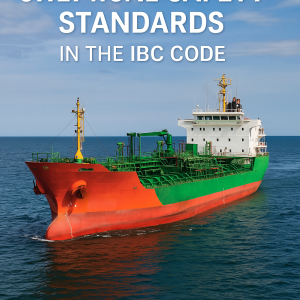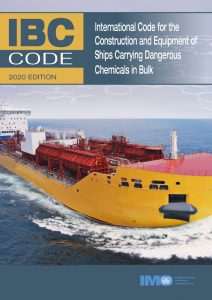Discover the top 6 chemical safety standards in the IBC Code that ensure the safe transport of hazardous liquid chemicals at sea. This guide explains each standard with real-world relevance, industry data, and international compliance strategies.

Why Chemical Safety at Sea Matters
Transporting hazardous liquid chemicals by sea is one of the most complex operations in maritime logistics. A single misstep can lead to environmental disasters, loss of life, or catastrophic vessel damage. That’s why the International Code for the Construction and Equipment of Ships Carrying Dangerous Chemicals in Bulk (IBC Code) exists.
Adopted by the International Maritime Organization (IMO) and enforced under SOLAS and MARPOL, the IBC Code outlines mandatory requirements for the design, construction, and equipment of chemical tankers. These standards safeguard human lives, marine ecosystems, and global trade operations. In this article, we break down the top 6 chemical safety standards in the IBC Code that every maritime professional should understand and implement.
1. Cargo Classification and Hazard Control
The IBC Code classifies over 400 different chemicals based on their toxicity, flammability, reactivity, and corrosivity. This classification determines the required ship type (Type 1, 2, or 3), which corresponds to the level of hazard mitigation required.
For example:
- Type 1 ships carry the most hazardous cargo and require the highest level of protection.
- Type 3 ships transport lower-risk substances.
Each chemical’s Product Data Sheet (PDS) details critical safety and handling parameters, such as flash point, reactivity with water, and emergency response protocols.
Example: A Type 1 ship may be used to carry benzene, while a Type 3 ship could carry molasses.
2. Tank Construction Standards and Materials
Cargo tanks on chemical tankers must be built with materials compatible with the chemicals they carry. The IBC Code mandates specific steel types, coatings, and linings that resist corrosion, chemical reaction, or absorption.
- Stainless steel is commonly used for corrosive acids.
- Special epoxy coatings may be required for alcohols or solvents.
Tank separation, structural integrity, and placement away from the ship’s hull are also outlined to reduce the risk of structural breach in an accident.
Wärtsilä and Alfa Laval are among the industry leaders in cargo handling systems aligned with IBC standards.
3. Ventilation and Vapor Control Systems
Toxic fumes or flammable vapors from chemical cargoes present constant risk. The IBC Code requires dedicated ventilation systems and vapor control mechanisms to prevent over-pressurization and reduce explosion or suffocation hazards.
These systems must:
- Prevent air ingress and cargo contamination
- Allow controlled release of vapors through scrubbers or flame arrestors
- Maintain inert gas atmospheres for flammable cargoes
IMO Model Course 1.10 and various DNV/ABS design reviews provide guidelines for vapor recovery systems.
4. Cargo Transfer and Emergency Shutoff Systems
Safe transfer of chemicals from ship to shore (or vice versa) requires stringent controls. The IBC Code specifies:
- Closed loading systems to minimize spillage
- Emergency shutdown (ESD) valves that instantly isolate cargo flow in emergencies
- Redundant pumping systems with alarms and pressure monitoring
Following a 2022 incident involving methanol leakage in a European port, ESD upgrades became mandatory under port state inspections influenced by Paris MoU reports.
5. Crew Training and Operational Procedures
No safety standard is effective without proper human operation. The IBC Code references the STCW Convention to ensure crew members handling chemical cargoes undergo specialized training.
Training includes:
- Chemical-specific hazard awareness
- Emergency procedures and personal protective equipment (PPE)
- Cargo handling simulations (e.g., as used in IMAREST/ICS-approved courses)
Documentation, such as Cargo Record Books and Cargo Compatibility Charts, is also vital to prevent dangerous interactions.
A 2021 study by The Nautical Institute found that over 60% of chemical spill incidents involved procedural or training errors rather than equipment faults.
6. Pollution Prevention and MARPOL Integration
The IBC Code aligns with MARPOL Annex II, which governs pollution prevention from noxious liquid substances. Discharge criteria include:
- Cargo residue control (using stripping systems and prewash procedures)
- Designated Reception Facilities in ports
- Record-keeping of tank washings and slop management
New technologies like automated tank cleaning machines and zero-discharge cargo systems are increasingly deployed to meet stricter standards.
According to EMSA and IMO data (2023), over 95% of chemical tankers now use high-efficiency stripping systems in compliance with MARPOL and IBC provisions.

Case Study: IBC Code Compliance in a Real-World Chemical Tanker
The “MT NovaChem” operates under DNV classification and carries chemicals including ethylene dichloride and toluene. Following a Port State Control (PSC) inspection in Rotterdam (2022), deficiencies in vapor control and PPE availability were flagged.
The operator responded by upgrading vapor recovery units and retraining crew based on IMO Model Course 1.10. Within six months, the vessel received full clearance and a safety commendation under the Paris MoU.
Challenges and Evolving Solutions
- Multinational Compliance: Vessels often face inconsistent enforcement across flag states. Organizations like IACS and ICS push for standardization.
- New Chemicals: The shipping of lithium derivatives, biofuels, and green ammonia pose novel hazards not fully addressed in earlier IBC revisions.
- Cybersecurity: Increasing digitalization of chemical handling systems introduces new vulnerabilities requiring attention under ISM and SOLAS Chapter XI-2.
FAQ: Common Questions About the IBC Code
What does IBC stand for in maritime safety?
IBC stands for “International Bulk Chemical” Code. It governs the safe design and operation of chemical tankers.
Are all chemical tankers required to follow the IBC Code?
Yes. Ships built after 1986 must comply fully with the IBC Code. Older ships may follow the BCH Code but are being phased out.
Who enforces IBC Code compliance?
Enforcement comes from flag states, Port State Control (PSC), and classification societies like Lloyd’s Register, DNV, and ClassNK.
What role does MARPOL play in the IBC Code?
The IBC Code complements MARPOL Annex II, focusing on pollution prevention from noxious liquid substances.
Is crew training mandatory under the IBC Code?
Yes. STCW-certified training is required for officers involved in chemical cargo handling.
Conclusion
The IBC Code is more than just a technical checklist—it’s a lifeline for the safety of crews, marine environments, and international commerce. By understanding the six core standards we’ve covered, seafarers and ship operators can better navigate the complex world of chemical transport.
As the maritime industry evolves toward greener fuels and newer substances, the IBC Code will continue to adapt—and so must we.
References
- IMO. (2022). IBC Code Text & Amendments. https://www.imo.org
- DNV. (2023). Chemical Tanker Guidelines. https://www.dnv.com
- The Nautical Institute. (2021). Chemical Tanker Operations Safety Report
- EMSA. (2023). Annual Safety Performance Report
- Wärtsilä. (2023). Cargo Handling Solutions https://www.wartsila.com
- Alfa Laval. (2023). Tank Cleaning Systems https://www.alfalaval.com
- ICS. (2022). Maritime Industry Compliance Roadmap


Safety first ,on all ahips